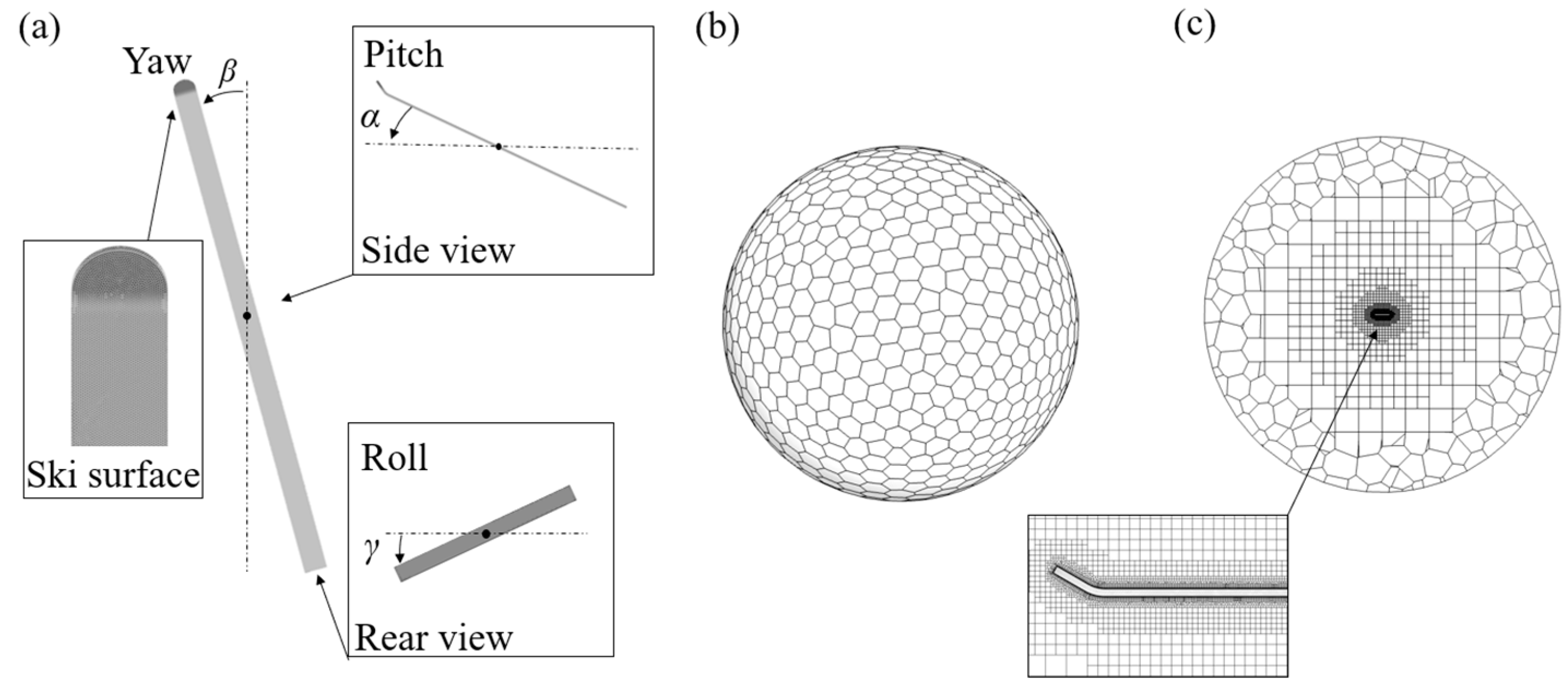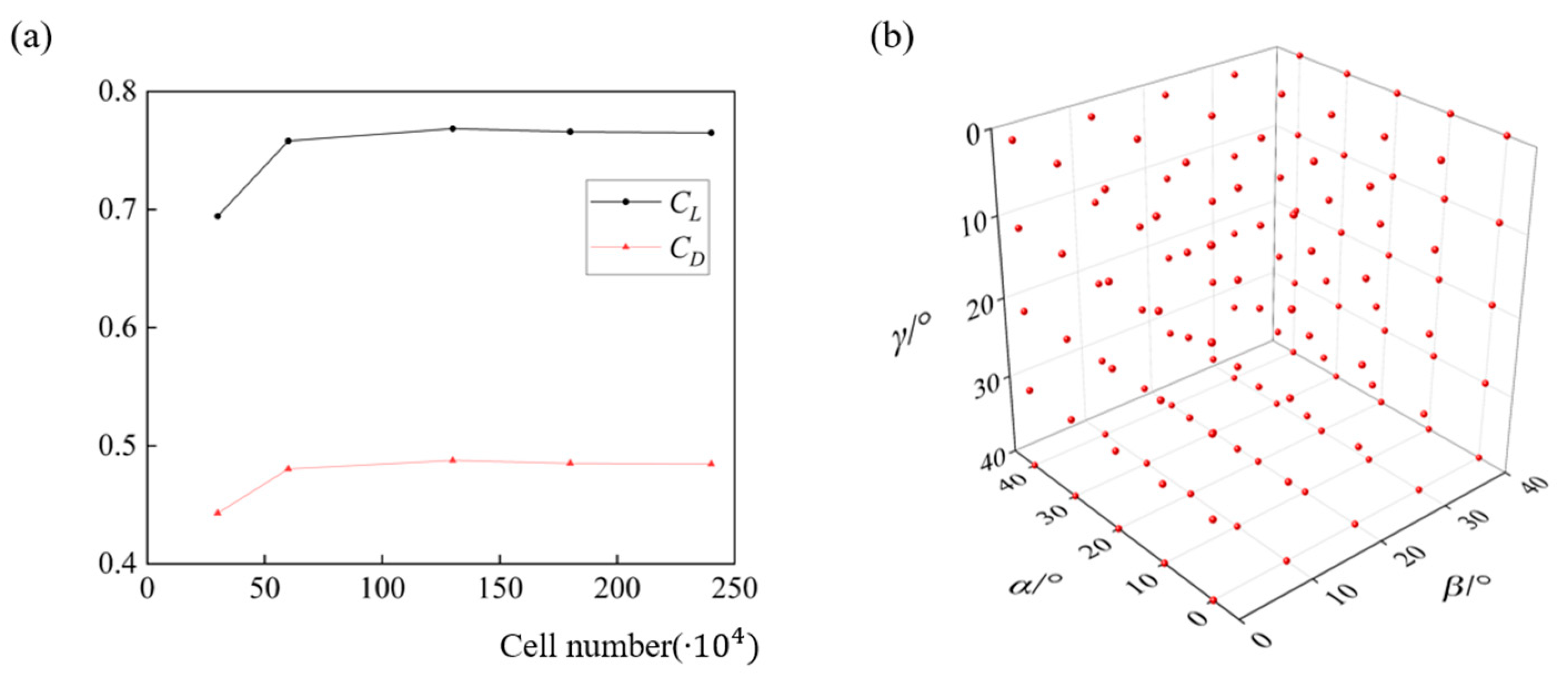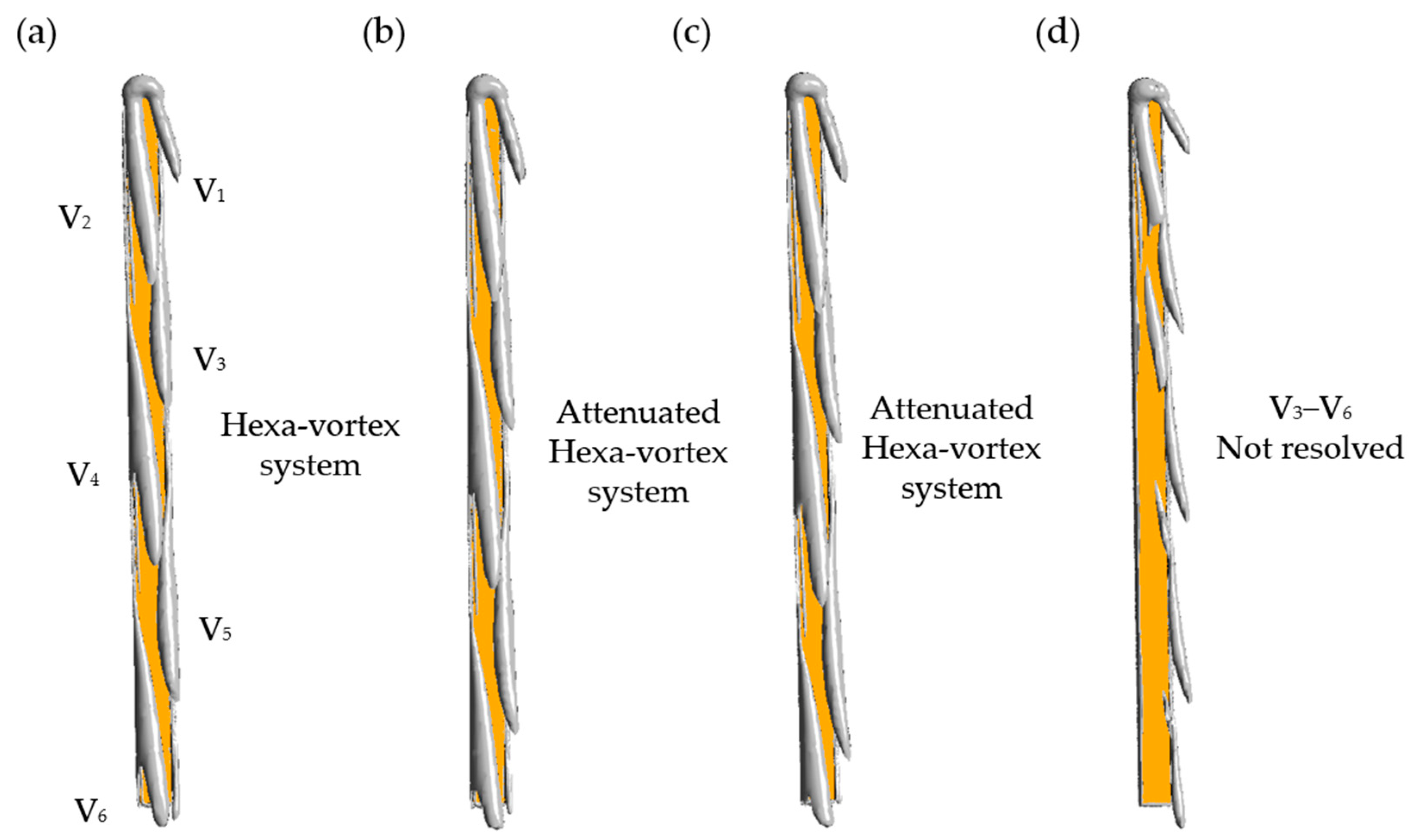Optimization of Ski Attitude for the In-Flight Aerodynamic Performance of Ski Jumping
Abstract
Simple Summary
Abstract
1. Introduction
2. Methods
2.1. Numerical Simulation
2.2. Optimization Strategy
2.2.1. Kriging Model
2.2.2. Expectation Improvement (EI) Criteria
2.2.3. Constraint of Lift Capacity
2.2.4. Optimization Process
3. Optimization Results
3.1. Unconstrained Optimization for CL/CD
3.2. Constrained Optimization for CL/CD
3.3. Flow Field Analysis
4. Discussion
5. Conclusions
Author Contributions
Funding
Institutional Review Board Statement
Informed Consent Statement
Data Availability Statement
Acknowledgments
Conflicts of Interest
References
- Alam, F.; Chowdhury, H.; Moria, H. A review on aerodynamics and hydrodynamics in sports. Energy Procedia 2019, 160, 798–805. [Google Scholar] [CrossRef]
- Elfmark, O.; Ettema, G. Aerodynamic investigation of the inrun position in ski jumping. Sports Biomech. 2021, 3, 1–15. [Google Scholar] [CrossRef] [PubMed]
- Virmavirta, M.; Isolehto, J.; Komi, P.; Schwameder, H.; Pigozzi, F.; Massazza, G. Take-off analysis of the olympic ski jumping competition (HS-106m). J. Biomech. 2009, 42, 1095–1101. [Google Scholar] [CrossRef]
- Ettema, G.J.C.; Bråten, S.; Bobbert, M.F. Dynamics of the in-run in ski jumping: A simulation study. J. Appl. Biomech. 2005, 21, 247–259. [Google Scholar] [CrossRef]
- Virmavirta, M.; Kivekäs, J.; Komi, P.V. Take-off aerodynamics in ski jumping. J. Biomech. 2001, 34, 465–470. [Google Scholar] [CrossRef]
- Remizov, L.P. Biomechanics of optimal flight in ski-jumping. J. Biomech. 1984, 17, 167–171. [Google Scholar] [CrossRef]
- Seo, K.; Murakami, M.; Yoshida, K. Optimal flight technique for v-style ski jumping. Sports Eng. 2004, 7, 97–103. [Google Scholar] [CrossRef]
- Virmavirta, M.; Kivekäs, J. Aerodynamics of an isolated ski jumping ski. Sports Eng. 2019, 22, 8. [Google Scholar] [CrossRef]
- Zhao, T.Y.; Ma, Y.; Zhang, H.Y.; Pan, H.G.; Cai, Y. Free vibration analysis of a rotating graphene nanoplatelet reinforced pre-twist blade-disk assembly with a setting angle. Appl. Math. Model. 2021, 93, 578–596. [Google Scholar] [CrossRef]
- Zhao, T.; Li, K.; Ma, H. Study on dynamic characteristics of a rotating cylindrical shell with uncertain parameters. Anal. Math. Phys. 2022, 12, 1–28. [Google Scholar] [CrossRef]
- Zhao, T.Y.; Jiang, L.P.; Pan, H.G.; Yang, J.; Kitipornchai, S. Coupled free vibration of a functionally graded pre-twisted blade-shaft system reinforced with graphene nanoplatelets. Compos. Struct. 2021, 262, 113362. [Google Scholar] [CrossRef]
- Zhao, T.Y.; Cui, Y.S.; Pan, H.G.; Kéki, S. Free vibration analysis of a functionally graded graphene nanoplatelet reinforced disk-shaft assembly with whirl motion. Int. J. Mech. Sci. 2021, 197, 106335. [Google Scholar] [CrossRef]
- Zhao, T.Y.; Yan, K.; Li, H.W.; Wang, X. Study on theoretical modeling and vibration performance of an assembled cylindrical shell-plate structure with whirl motion. Appl. Math. Model. 2022, 110, 618–632. [Google Scholar] [CrossRef]
- Meile, W.; Reisenberger, E.; Mayer, M.; Schmölzer, B.; Müller, W.; Brenn, G. Aerodynamics of ski jumping: Experiments and CFD simulations. Exp. Fluids 2006, 41, 949–964. [Google Scholar] [CrossRef]
- Yamamoto, K.; Tsubokura, M.; Ikeda, J.; Onishi, K.; Baleriola, S. Effect of posture on the aerodynamic characteristics during take-off in ski jumping. J. Biomech. 2016, 49, 3688–3696. [Google Scholar] [CrossRef]
- Kim, W.; Lee, H.; Lee, J.; Jung, D.; Choi, H. Flow over a ski jumper in flight: Prediction of the aerodynamic force and flight posture with higher lift-to-drag ratio. J. Biomech. 2019, 89, 78–84. [Google Scholar] [CrossRef]
- Defraeye, T.; Blocken, B.; Koninckx, E.; Hespel, P.; Carmeliet, J. Computational fluid dynamics analysis of cyclist aerodynamics: Performance of different turbulence-modelling and boundary-layer modelling approaches. J. Biomech. 2010, 43, 2281–2287. [Google Scholar] [CrossRef]
- Barber, S.; Chin, S.B.; Carré, M.J. Sports ball aerodynamics: A numerical study of the erratic motion of soccer balls. Comput. Fluids 2009, 38, 1091–1100. [Google Scholar] [CrossRef][Green Version]
- Bixler, B.; Riewald, S. Analysis of a swimmer’s hand and arm in steady flow conditions using computational fluid dynamics. J. Biomech. 2002, 35, 713–717. [Google Scholar] [CrossRef]
- Bixler, B.; Pease, D.; Fairhurst, F. The accuracy of computational fluid dynamics analysis of the passive drag of a male swimmer. Sports Biomech. 2007, 6, 81–98. [Google Scholar] [CrossRef]
- Shim, H.-S.; Lee, Y.-N.; Kim, K.-Y. Optimization of bobsleigh bumper shape to reduce aerodynamic drag. J. Wind. Eng. Ind. Aerodyn. 2017, 164, 108–118. [Google Scholar] [CrossRef]
- Gong, X.; Gu, Z.; Li, Z. Surrogate model for aerodynamic shape optimization of a tractor-trailer in crosswinds. Proc. Inst. Mech. Eng. Part D J. Automob. Eng. 2012, 226, 1325–1339. [Google Scholar] [CrossRef]
- Lee, K.-D.; Park, M.-J.; Kim, K.-Y. Optimization of ski jumper’s posture considering lift-to-drag ratio and stability. J. Biomech. 2012, 45, 2125–2132. [Google Scholar] [CrossRef] [PubMed]
- Zhang, L.; Li, X.; Wang, X.; Chen, L.; Zhao, T. Performance and biomechanics in the flight period of ski jumping: Influence of ski attitude. Biology 2022, 11, 671. [Google Scholar] [CrossRef]
- Tang, E.; Wei, Z.; Fogel, M.A.; Veneziani, A.; Yoganathan, A.P. Fluid-structure interaction simulation of an intra-atrial fontan connection. Biology 2020, 9, 412. [Google Scholar] [CrossRef]
- Gardan, N.; Schneider, A.; Polidori, G.; Trenchard, H.; Seigneur, J.M.; Beaumont, F.; Fourchet, F.; Taiar, R. Numerical investigation of the early flight phase in ski-jumping. J. Biomech. 2017, 59, 29–34. [Google Scholar] [CrossRef]
- Martin, J.D.; Simpson, T.W. On the use of kriging models to approximate deterministic computer models. In Proceedings of the Volume 1: 30th Design Automation Conference, ASMEDC, Salt Lake City, UT, USA, 1 January 2004; pp. 481–492. [Google Scholar]
- Queipo, N.V.; Haftka, R.T.; Shyy, W.; Goel, T.; Vaidyanathan, R.; Kevin Tucker, P. Surrogate-based analysis and optimization. Prog. Aerosp. Sci. 2005, 41, 1–28. [Google Scholar] [CrossRef]
- Jang, C.-M.; Kim, K.-Y. Optimization of a stator blade using response surface method in a single-stage transonic axial compressor. Proc. Inst. Mech. Eng. Part A J. Power Energy 2005, 219, 595–603. [Google Scholar] [CrossRef]
- Kim, H.-M.; Kim, K.-Y. Shape optimization of three-dimensional channel roughened by angled ribs with RANS analysis of turbulent heat transfer. Int. J. Heat Mass Transf. 2006, 49, 4013–4022. [Google Scholar] [CrossRef]
- Samad, A.; Kim, K.-Y.; Goel, T.; Haftka, R.T.; Shyy, W. Multiple surrogate modeling for axial compressor blade shape optimization. J. Propuls. Power 2008, 24, 301–310. [Google Scholar] [CrossRef]
- Yu, K.; Yang, X.; Yue, Z. Aerodynamic and heat transfer design optimization of internally cooling turbine blade based different surrogate models. Struct. Multidisc. Optim. 2011, 44, 75–83. [Google Scholar] [CrossRef]
- Floudas, C.A.; Gounaris, C.E. A review of recent advances in global optimization. J. Glob. Optim. 2009, 45, 3–38. [Google Scholar] [CrossRef]
- Jeong, J.; Hussain, F. On the identification of a vortex. J. Fluid Mech. 1995, 285, 69–94. [Google Scholar] [CrossRef]
- Mariotti, A.; Galletti, C.; Brunazzi, E.; Salvetti, M.V. Steady flow regimes and mixing performance in arrow-shaped micro-mixers. Phys. Rev. Fluids 2019, 4, 034201. [Google Scholar] [CrossRef]
- Schwameder, H.; Müller, E. Biomechanics in ski jumping: A review. Eur. J. Sport Sci. 2001, 1, 1–16. [Google Scholar] [CrossRef]
- Virmavirta, M.; Isolehto, J.; Komi, P.; Brüggemann, G.-P.; Müller, E.; Schwameder, H. Characteristics of the early flight phase in the olympic ski jumping competition. J. Biomech. 2005, 38, 2157–2163. [Google Scholar] [CrossRef]







| Iteration | α/° | β/° | γ/° | (CL/CD)KRG | (CL/CD)CFD | Error | EIMAX |
|---|---|---|---|---|---|---|---|
| 0 | 10.06 | 16.31 | 0.3516 | 3.360 | 3.356 | 0.1192% | 0.07756 |
| 1 | 10.00 | 17.39 | 0.09768 | 3.358 | 3.340 | 0.5389% | 0.03810 |
| 2 | 10.54 | 23.70 | 0.08791 | 3.441 | 3.246 | 6.007% | 0.04523 |
| 3 | 11.21 | 7.717 | 2.647 | 3.647 | 3.004 | 21.40% | 0.08894 |
| 4 | 12.97 | 17.41 | 0.01954 | 3.604 | 3.020 | 19.34% | 0.1750 |
| 5 | 10.00 | 15.89 | 2.803 | 3.481 | 3.301 | 5.453% | 0.1421 |
| 6 | 10.43 | 13.38 | 0.2930 | 3.415 | 3.371 | 1.305% | 0.1269 |
| 7 | 10.00 | 19.86 | 1.260 | 3.380 | 3.283 | 2.955% | 0.05140 |
| 8 | 10.14 | 11.75 | 1.846 | 3.407 | 3.313 | 2.837% | 0.007313 |
| 9 | 10.27 | 13.71 | 0.8107 | 3.379 | 3.370 | 0.2837% | 0.02844 |
| 10 | 10.05 | 26.81 | 0.06837 | 3.484 | 3.297 | 5.672% | 0.009051 |
| 11 | 10.03 | 13.66 | 0.4300 | 3.409 | 3.407 | 0.05870% | 0.001609 |
| 12 | 10.00 | 13.19 | 0.08791 | 3.415 | 3.411 | 0.1173% | 0.0005491 |
| Constraint | α/° | β/° | γ/° | (CL/CD)KRG | (CL/CD)CFD | Δ | (CL)KRG | (CL)CFD |
|---|---|---|---|---|---|---|---|---|
| CL > 0.8 | 27.58 | 21.69 | 5.695 | 1.604 | 1.603 | 0.06238% | 0.8001 | 0.7992 |
| CL > 0.7 | 23.68 | 21.81 | 6.251 | 1.849 | 1.841 | 0.4345% | 0.7001 | 0.6957 |
| CL > 0.6 | 21.68 | 20.67 | 3.370 | 2.086 | 2.081 | 0.2403% | 0.6006 | 0.6056 |
| CL > 0.5 | 16.21 | 31.62 | 1.631 | 2.494 | 2.403 | 3.787% | 0.5007 | 0.5015 |
| None | 10.00 | 13.19 | 0.08791 | 3.415 | 3.411 | 0.1173% | 0.1909 | 0.1921 |
Publisher’s Note: MDPI stays neutral with regard to jurisdictional claims in published maps and institutional affiliations. |
© 2022 by the authors. Licensee MDPI, Basel, Switzerland. This article is an open access article distributed under the terms and conditions of the Creative Commons Attribution (CC BY) license (https://creativecommons.org/licenses/by/4.0/).
Share and Cite
Cao, L.; Guo, Y.; Li, X.; Chen, L.; Wang, X.; Zhao, T. Optimization of Ski Attitude for the In-Flight Aerodynamic Performance of Ski Jumping. Biology 2022, 11, 1362. https://doi.org/10.3390/biology11091362
Cao L, Guo Y, Li X, Chen L, Wang X, Zhao T. Optimization of Ski Attitude for the In-Flight Aerodynamic Performance of Ski Jumping. Biology. 2022; 11(9):1362. https://doi.org/10.3390/biology11091362
Chicago/Turabian StyleCao, Lianzhong, Youcai Guo, Xiong Li, Long Chen, Xin Wang, and Tianyu Zhao. 2022. "Optimization of Ski Attitude for the In-Flight Aerodynamic Performance of Ski Jumping" Biology 11, no. 9: 1362. https://doi.org/10.3390/biology11091362
APA StyleCao, L., Guo, Y., Li, X., Chen, L., Wang, X., & Zhao, T. (2022). Optimization of Ski Attitude for the In-Flight Aerodynamic Performance of Ski Jumping. Biology, 11(9), 1362. https://doi.org/10.3390/biology11091362











